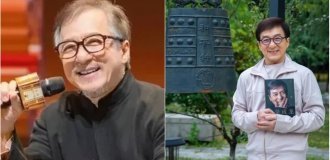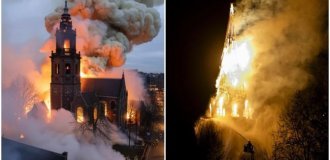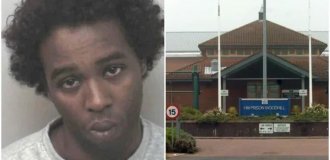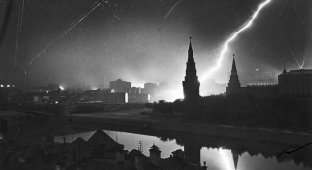Heroes of the Great Patriotic War (29 photos)
1. Ivan Timofeevich Lyubushkin (1918-1942)
In the fall of 1941, there were fierce battles in the area of the city of Orel. Soviet tank crews fought off the fierce attacks of the Nazis. At the beginning of the battle, Senior Sergeant Lyubushkin's tank was damaged by an enemy shell and could not move. The crew took on an unequal battle with fascist tanks pressing from all sides. Five enemy vehicles were destroyed by courageous tankers! During the battle, another shell hit Lyubushkin’s car and the crew was wounded.
The tank commander continued to fire at the advancing fascists and ordered the driver to repair the damage. Soon Lyubushkin's tank was able to move and joined its column.
For courage and bravery, I. T. Lyuboshkin was awarded the title of Hero of the Soviet Union on October 10, 1941.
In one of the battles in June 1942, Lyubushkin died a heroic death.
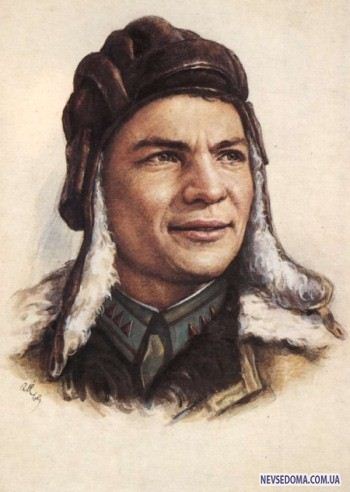
2. Alexander Matveevich Matrosov (1924-1943)
On February 23, 1943, fierce battles broke out on one of the sections of the Kalinin Front near the village of Chernushki, north of the city of Velikiye Luki. The enemy turned the village into a heavily fortified stronghold. Several times the soldiers launched an attack on the fascist fortifications, but destructive fire from the bunker blocked their path. Then a private of the Sailors Guard, making his way to the bunker, covered the embrasure with his body. Inspired by Matrosov’s feat, the soldiers went on the attack and drove the Germans out of the village.
For his feat, A. M. Matrosov was posthumously awarded the title of Hero of the Soviet Union.
Today, the regiment in which Sailors served bears the name of a hero who is forever included in the unit’s lists.

3. Nelson Georgievich Stepanyan (1913-1944)
During the Great Patriotic War, the commander of the assault regiment Stepanyan made 293 successful combat missions to attack and bomb enemy ships.
Stepanyan became famous for his high skill, surprise and audacity of striking the enemy. One day, Colonel Stepanyan led a group of planes to bomb an enemy airfield. The attack aircraft dropped their bombs and began to leave. But Stepanyan saw that several fascist planes remained undamaged. Then he directed his plane back, and approaching the enemy airfield, he lowered the landing gear. The enemy's anti-aircraft artillery stopped firing, thinking that the Soviet plane was voluntarily landing on their airfield. At this moment, Stepanyan stepped on the gas, retracted the landing gear and dropped the bombs. All three aircraft that survived the first raid burst into flames with torches. And Stepanyan’s plane landed safely at its airfield.
On October 23, 1942, for the excellent performance of command tasks, the glorious son of the Armenian people was awarded the title of Hero of the Soviet Union. He was awarded a second Gold Star medal posthumously on March 6, 1945.

4. Vasily Georgievich Klochkov (1911-1941)
November 1941. Moscow has been declared in a state of siege. In the Volokolamsk direction, in the area of the Dubosekovo crossing, 28 soldiers of the rifle division of Major General I.V. Panfilov, led by political instructor Klochkov, fought to the death.
On November 16, the Nazis sent a company of machine gunners against them. But all enemy attacks were repulsed. The Nazis left about 70 corpses on the battlefield. After some time, the Nazis moved 50 tanks against 28 brave men. The soldiers, led by the political instructor, courageously entered into an unequal battle. One after another, valiant warriors fell to the ground, struck down by fascist bullets. When the cartridges ran out and the grenades were running out, political instructor Klochkov gathered the surviving soldiers around him and, with grenades in his hands, went towards the enemy.
At the cost of their own lives, Panfilov’s men did not let the enemy tanks rush towards Moscow. The Nazis left 18 damaged and burned vehicles on the battlefield.
For unparalleled heroism, courage and bravery, political instructor V. G. Klochkov was posthumously awarded the title of Hero of the Soviet Union.
After the war, a monument was erected to the Panfilov heroes at the Dubosekovo crossing.

5. Alexander Mikhailovich Roditelev (1916-1966)
During the battles for Koenigsberg in April 1945, the commander of a sapper platoon, junior lieutenant Roditelev, and eight sappers acted as part of an assault group.
With a swift rush, the assault group reached the enemy artillery positions. Wasting no time, Roditelev ordered the artillerymen to attack. In the ensuing hand-to-hand combat, he himself destroyed six fascists. Unable to withstand the onslaught of Soviet soldiers, 25 German soldiers surrendered, the rest fled, leaving 15 heavy guns. A few minutes later, the Nazis attempted to return the abandoned guns. The sappers repulsed three counterattacks and held artillery positions until the main forces marched. In this battle, a group of sappers under the command of Roditelev destroyed up to 40 Nazis and captured 15 serviceable heavy guns. The next day, April 8, Roditelev with twelve sappers blew up an enemy bunker, cleared 6 city blocks of Nazis and captured up to 200 soldiers and officers.
ditch
For the courage and bravery shown in battles with the German fascists, A. M. Roditelev was awarded the title of Hero of the Soviet Union.

6. Vladimir Dmitrievich Lavrinenkov (Born 1919)
Fighter pilot Lavrinenkov spent his first battle near Stalingrad. Soon he already had 16 enemy aircraft destroyed. With each flight his skill grew and strengthened. In battle, he acted decisively and boldly. The number of enemy aircraft shot down increased. Together with his comrades, he covered attack aircraft and bombers, repelled enemy air raids, conducting air battles - lightning battles with the enemy, from which he always emerged victorious.
By the end of the war, the communist Lavrinenkov had 448 combat missions, 134 air battles, in which he personally shot down 35 enemy aircraft and 11 as part of a group.
The Motherland twice awarded V.D. Lavrinenkov with the Gold Star medals of the Hero of the Soviet Union.

7. Viktor Dmitrievich Kuskov (1924-1983)
The motorman of the torpedo boat Kuskov fought throughout the war on the ships of the Red Banner Baltic Fleet. The boat on which he served took part in 42 combat operations and sank 3 enemy ships.
In one of the battles, a direct hit from an enemy shell into the engine compartment destroyed the left engine and damaged the oil line of the second engine. Kuskov himself was seriously shell-shocked. Overcoming the pain, he reached the engine and closed the hole in the oil line with his hands. The hot oil burned his hands, but he unclenched them only when the boat left the battle and broke away from the enemy.
In another battle, in June 1944, a direct hit from an enemy shell started a fire in the engine room. Kuskov was seriously wounded, but continued to remain at his post, fighting the fire and water that flooded the engine compartment. However, the ship could not be saved. Kuskov, together with Petty Officer Matyukhin, lowered the crew members into the water using lifebelts, and the seriously wounded boat commander and officer were held in the water in their arms for two hours until our ships arrived.
For fearlessness and dedication, a high understanding of military duty and saving the life of the ship commander, communist V.D. Kuskov was awarded the title of Hero of the Soviet Union on July 22, 1944.

8. Rufina Sergeevna Gasheva (Born 1921)
School, a pioneer detachment, three years of study at Moscow State University - this ordinary biography was radically changed by the war. 848 combat missions are recorded in the summer book of Rufina Gasheva, navigator of the squadron of the 46th Guards Taman Light Bomber Regiment. More than once she had to find herself in difficult situations. In one of the battles in Kuban, Gesheva’s plane was shot down by a fascist fighter and fell behind the front line. For several days, the girl made her way behind enemy lines to her regiment, where she was already considered dead. Near Warsaw, having parachuted out of a burning plane, she landed on a minefield.
In 1956, Rufina Sergeevna Gasheva was demobilized with the rank of major. She taught English at the Academy of Armored Forces named after R. Ya. Malinovsky, worked at Voenizdat. Since 1972 she has been retired in Moscow. For the courage shown in battles with the enemy, Rufina Sergeevna Gasheva was awarded the title of Hero of the Soviet Union on February 23, 1945.

9. Caesar Lvovich Kunikov (1909-1943)
On the night of February 3-4, 1943, a landing detachment of sailors under the command of Major Kunikov landed on the enemy-occupied and heavily fortified coast in the Novorossiysk region. With a swift blow, the landing detachment knocked out the Nazis from the point and firmly entrenched itself in the captured bridgehead. At dawn a fierce battle broke out. During the day, the paratroopers repelled 18 enemy attacks. By the end of the day, ammunition was running low. The situation seemed hopeless. Then Major Kunikov’s detachment made a surprise raid on an enemy artillery battery. Having destroyed the gun crew and captured the guns, they opened fire on the attacking enemy soldiers.
For seven days, the paratroopers repulsed fierce enemy attacks and held the bridgehead until the main forces arrived. During this period, the detachment destroyed over 200 Nazis. In one of the battles, Kunikov was mortally wounded.
For his courage and courage, the communist Ts. L. Kunikov was posthumously awarded the title of Hero of the Soviet Union.

10. Evgenia Maksimovna Rudneva (1921-1944)
In the first days of the Great Patriotic War, MSU student Zhenya Rudneva volunteered to go to the front. During the course she mastered the art of navigating. And then there were successful bombings of concentrations of enemy troops and enemy equipment in the Kuban, North Caucasus, and Crimea. The navigator of the Guards Bomber Aviation Regiment, Senior Lieutenant Rudneva, made 645 combat missions. In April 1944, while carrying out another combat mission in the Kerch region, E. M. Rudneva died heroically. 26 ok
In September 1944, the navigator of the Guards Bomber Regiment, Evgenia Maksimovna Rudneva, was posthumously awarded the title of Hero of the Soviet Union.

11. Igor Pavlovich Dolzhenkov (1914-1980)
There were heavy battles for the liberation of the city of Melitopol from the Nazi invaders. In one of the battles, Senior Lieutenant Dolzhenkov’s battery was controlled by an enemy company, supported by seven tanks. An unequal battle broke out, as a result of which the enemy lost three tanks. But Dolzhenkov also had only one gun left intact. Despite the enemy's numerical superiority, the battery commander continued to fight and knocked out another tank. Enemy infantry surrounded the Soviet fighters and tried to destroy them. Then the communist Dolzhenkov gathered the available battery and quickly attacked the enemy. As a result of the successful attack, more than 40 Nazi soldiers and officers were killed.
For courage and bravery, by the Decree of the Presidium of the Supreme Soviet of the USSR dated January 1, 1943, I. P. Dolzhenkov was awarded the title of Hero of the Soviet Union.

12. Manshuk Zhiengalievna Mametova (1922-1943)
The best machine gunner of the 21st Guards Rifle Division was considered a Kazakh girl, Manshuk Mametova. She was an example of valor and fearlessness, the pride of the division’s fighters.
On October 15, 1943, there was a fierce battle for the city of Nevel. Manshuk supported the advance of her unit with machine-gun fire. She was wounded in the head. Gathering her last strength, the girl pulled the machine gun into an open position and began shooting the Nazis point-blank, clearing the way for her comrades. Even dead, Manshuk clutched the handles of the machine gun...
From all over our Motherland letters were sent to Alma-Ata, where Manshuk lived and where she left for a great feat. And in Nevel, near whose walls the heroine died, there is a street named after her. The courageous machine gunner was awarded the title of Hero of the Soviet Union posthumously on March 1, 1944.

13. Elena Fedorovna Kolesova (1921-1942)
On a frosty November night in 1941 near Moscow, a detachment of girl reconnaissance girls, led by twenty-year-old Muscovite Komsomol member Elena Kolesova, went behind enemy lines. For exemplary performance of this task, Lelya Kolesova was awarded the Order of the Red Banner. Since April 1942, Kolesova’s group operated in one of the districts of the Minsk region. Under the leadership of its brave commander, the group collected and transmitted information about the location of the Nazis, the transfer of enemy troops and military equipment, passed highways and railways, blew up enemy trains and bridges. On September 11, 1942, Elena Kolesova died in an unequal battle with punitive forces near the village of Vydritsa, Minsk Region. The heroine’s name was borne by the pioneer squad of Moscow school No. 47, where she worked as a pioneer leader and teacher. The glorious intelligence officer, who gave her life for the freedom and independence of our Motherland, was posthumously awarded the title of Hero of the Soviet Union on February 21, 1944.

14. Anatoly Konstantinovich Avdeev, gunner of a fighter anti-tank artillery regiment, born in 1925.
On July 5, 1944, Avdeev’s gun crew was ordered to prevent the fascist troops from breaking out of the encirclement in the Volma region (Belarus). Having taken up an open firing position, the soldiers shot the Nazis at point-blank range. The battle lasted 13 hours. During this time, the gun crew repelled 7 attacks. Almost all the shells ran out, and 5 gun crew members died the death of the brave. The enemy is attacking again. Avdeev's gun is damaged by a direct hit from a shell, and the last soldier in the crew is killed. Left alone, Avdeev does not leave the battlefield, but continues to fight with a machine gun and grenades. But now all the cartridges and the last grenade have been used up. The Komsomol member grabs an ax lying nearby and destroys four more fascists.
Mission accomplished. The enemy did not pass, leaving up to 180 corpses of soldiers and officers, 2 self-propelled guns, a machine gun and 4 vehicles on the battlefield in front of Avdeev’s gun.
By decree of the Presidium of the Supreme Soviet of the USSR, the glorious son of the Russian people, Avdeev, was awarded the title of Hero of the Soviet Union.

15. Vladimir Avramovich Alekseenko, deputy commander of an aviation regiment, born in 1923, Russian.
Attack aviation pilot Alekseenko completed 292 successful combat missions during the war years. He stormed enemy batteries shelling Leningrad, crushed the enemy on the Karelian Isthmus, in the Baltic states and in East Prussia. Dozens of aircraft shot down and destroyed at airfields, 33 tanks, 118 vehicles, 53 railway cars, 85 carts, 15 armored personnel carriers, 10 ammunition depots, 27 artillery pieces, 54 anti-aircraft guns, 12 mortars and hundreds of killed soldiers. and enemy officers - this is the combat account of Captain Alekseenko.
For 230 successful combat sorties on assault strikes against concentrations of troops and equipment
nicknames of the enemy, for courage and bravery the communist V. A. Alekseenko was awarded the title of Hero of the Soviet Union on April 19, 1945. On June 29, 1945, for new military exploits at the front, he was awarded a second Gold Star medal.

16. Andrei Egorovich Borovykh, commander of an aviation squadron, born in 1921, Russian.
During the Great Patriotic War, fighter pilot Andrei Borovoy fought on the Kalinin Front. His battle path ran through Orel and Kursk, Gomel and Brest, Lvov and Warsaw and ended near Berlin. He flew to intercept enemy aircraft, accompanied our bombers behind enemy lines, and conducted aerial reconnaissance. In the first two years of the war alone, Major Borovoy made 328 successful combat missions, participated in 55 air battles, in which he personally shot down 12 enemy aircraft.
In August 1943, the communist Borovykh was awarded the title of Hero of the Soviet Union. He was awarded the second Gold Star medal on February 23, 1945 for shooting down another 20 enemy aircraft in the next 49 air battles.
In total, during the war years, Borovoy made about 600 successful combat missions.
After the Great Patriotic War, A.E. Borovykh was elected as a deputy of the Supreme Soviet of the RSFSR and a deputy of the Supreme Soviet of the USSR.

17. Boris Aleksandrovich Vladimirov, commander of a rifle division, born in 1905, Russian.
General Vladimirov especially distinguished himself in January 1945 in the Vistula-Oder operation. As a result of a well-thought-out and skillfully organized battle, his division on January 14-15 successfully broke through the deeply echeloned German defenses at the line of the Vistula River. Pursuing the enemy, the division fought about 400 km from January 16 to 28, suffering minor losses in personnel and military equipment. The soldiers under the leadership of General Vladimirov were among the first to enter the territory of Nazi Germany and, having made a difficult maneuver in a wooded area, with fierce resistance from the Nazis, pushed them back from the border and defeated the five thousand-strong garrison of the city of Schneidemuhl. In the area of the city of Schneidemuhl, the division's soldiers captured huge trophies, including 30 trains with military equipment, food and military equipment.
For his skillful leadership of the division in difficult battle conditions and the personal courage and heroism shown, communist B. A. Vladimirov was awarded the title of Hero of the Soviet Union.

18. Alexander Borisovich Kazaev, commander of a rifle regiment, born in 1919, Ossetian.
On April 13, 1945, a rifle regiment under the command of Major Kazaev, conducting offensive battles against the fascist group on the Zemland Peninsula, approached a heavily fortified enemy defense line. All attempts to break through the defenses from the front were unsuccessful. The division's advance was stopped. Then Major Kazaev, with a daring and unexpected maneuver, blocked the enemy’s main stronghold with small forces, and with his main forces broke through the defenses from the flanks and ensured the successful offensive of the entire division.
During the offensive battles from April 13 to 17, 1945, Major Kazaev’s regiment destroyed more than 400 and captured 600 Nazi soldiers and officers, captured 20 guns and freed 1,500 prisoners languishing in concentration camps.
For his skillful leadership of the regiment's combat operations and his courage, A. V. Kazaev was awarded the title of Hero of the Soviet Union.

19. Konstantin Dionisievich Karitsky, commander of the 5th Leningrad Partisan Brigade, born in 1913, Ukrainian, communist.
A career border guard officer, Karitsky, commanded a fighter battalion in the first days of the Great Patriotic War. When fascist troops occupied the Leningrad region and approached Leningrad, Karitsky, as part of a special group, went behind enemy lines. In February 1943, he formed a partisan brigade. In difficult conditions, the brigade carries out raids, destroys fascist garrisons, blows up bridges and railways, and liberates populated areas from invaders. During the period of hostilities, the brigade restored Soviet power in 367 settlements and saved more than 40 thousand peaceful Soviet people from being taken into slavery. In the January and February battles of 1944, the partisan brigade, paralyzing the enemy’s communications, provided great assistance to the troops of the Leningrad, Volkhov and 2 Baltic fronts that went on the offensive.
For successful military operations and demonstrated personal courage and bravery, Colonel K. D. Karitsky was awarded the title of Hero of the Soviet Union.

20. Vasily Georgievich Klochkov. November 1941. Moscow has been declared in a state of siege. In the Volokolamsk direction, in the area of the Dubosekovo crossing, 28 soldiers of the rifle division of Major General I.V. Panfilov, led by political instructor Klochkov, fought to the death.
On November 16, the Nazis sent a company of machine gunners against them. But
all enemy attacks were repulsed. The Nazis left about 70 corpses on the battlefield. After some time, the Nazis moved 50 tanks against the 28 brave men. The soldiers, led by the political instructor, courageously entered into an unequal battle. One after another, valiant warriors fell to the ground, struck down by a fascist bullet. When the cartridges ran out and the grenades were running out, political instructor Klochkov gathered the surviving soldiers around him and, with grenades in his hands, went towards the enemy.
At the cost of their own lives, Panfilov’s men did not let the enemy tanks rush towards Moscow. The Nazis left 18 damaged and burned vehicles on the battlefield.
For unparalleled heroism, courage and courage, political instructor V. G. Klochkov was posthumously awarded the title of Hero of the Soviet Union.
After the war, a monument was erected to the Panfilov heroes at the Dubosekovo crossing.

21. Ermalai Grigorievich Koberidze, commander of a rifle division, born in 1904, Georgian, communist.
Career military man, Major General E. G. Koberidze on the fronts of the Great Patriotic War - since June 1941. He especially distinguished himself in battles in July 1944. On July 27, 1944, the division commander, General Koberidze, personally with the advanced detachment of the division went to the eastern bank of the Vistula and organized its crossing. Under heavy enemy fire, the fighters, inspired by the division commander, crossed to the west bank and captured a bridgehead there. Following the advance detachment, the entire division, waging heavy fighting, completely crossed over to the western bank of the river within two days and began consolidating and expanding the bridgehead.
For skillful management of the division in the battles for the Vistula and the personal heroism and courage shown at the same time, E. G. Koberidze was awarded the title of Hero of the Soviet Union.

22. Caesar Lvovich Kunikov, commander of the landing detachment of sailors at the Novorossiysk Naval Base of the Black Sea Fleet, Russian.
On the night of February 3-4, 1943, a landing detachment of sailors under the command of Major Kunikov landed on the enemy-occupied and heavily fortified coast in the Novorossiysk region. With a swift blow, the landing detachment knocked out the Nazis from the point and firmly entrenched itself in the captured bridgehead. At dawn a fierce battle broke out. The paratroopers repelled 18 enemy attacks during the day. By the end of the day, ammunition was running low. The situation seemed hopeless. Then Major Kunikov’s detachment made a surprise raid on an enemy artillery battery. Having destroyed the gun crew and captured the guns, they opened fire on the attacking enemy soldiers.
For seven days, the paratroopers repulsed fierce enemy attacks and held the bridgehead until the main forces arrived. During this period, the detachment destroyed over 200 Nazis. In one of the battles, Kunikov was mortally wounded.
For courage and courage, the communist Ts. L. Kunikov was posthumously awarded the title of Hero of the Soviet Union.

23. Ivan Gavrilovich Malin, commander of a reconnaissance platoon of a rifle regiment, Russian.
The squad leader, communist Malin, and his scouts more than once went on important and complex combat missions. During one of the searches, Malin's scouts met a large group of fascists. A hand-to-hand fight ensued. Malin personally killed 12 Nazis.
In October 1943, during the crossing of the Dnieper, Malin's scout squad was the first to be transported to the western bank of the river. Having landed on the shore, the soldiers began a battle with the Nazis, diverting their attention from the crossing of our main forces. Having repulsed all the counterattacks of the fascists, the squad held its position all day until the main forces arrived. In this battle, Sergeant Major Malin destroyed about 30 Nazis.
For his courage and heroism, Sergeant Major I. G. Malin was awarded the title of Hero of the Soviet Union.

24. Kafur Nasyrovich Mamedov. On October 18, 1942, a battalion of marines of the Black Sea Fleet, in which sailor Mamedov fought, fought a difficult battle with superior enemy forces. Nazi troops managed to break through and surround the company commander's command post. Sailor Mamedov rushed to the commander’s rescue and shielded him from the enemy’s attack with his chest. The brave warrior saved the commander at the cost of his own life.
For courage, bravery and self-sacrifice in the battle with the fascist invaders, the son of the Azerbaijani people, Komsomol member K. N. Mamedov was posthumously awarded the title of Hero of the Soviet Union.

25. Viktor Petrovich Miroshnichenko, commander of the construction and track department of the railway troops, Russian.
In the fall of 1941, fierce battles took place on the approaches to Tula. The bridge over the river was covered by a machine gun crew under the command of Sergeant Miroshnichenko. He was given the task of delaying the enemy for as long as possible and then blowing up the bridge. During a fierce battle, the machine gun crew died. Miroshnichenko was left alone. He was wounded, but
continued to fire at the advancing enemy. However, the forces were unequal, and Miroshnichenko decided to blow up the bridge. During the battle, the cords leading to the mined bridge were cut. Miroshnichenko was not at a loss. Overcoming the pain, he crawled to the fuse and set fire to its ends. At the cost of his own life, Sergeant Miroshnichenko eliminated the crossing on the path of the advancing fascist troops.
For courage and courage to Komsomol member V. II. Miroshnichenko was posthumously awarded the title of Hero of the Soviet Union. By order of the Minister of the Armed Forces of the USSR, Sergeant V.P. Miroshnichenko was forever included in the lists of a separate construction track railway battalion.
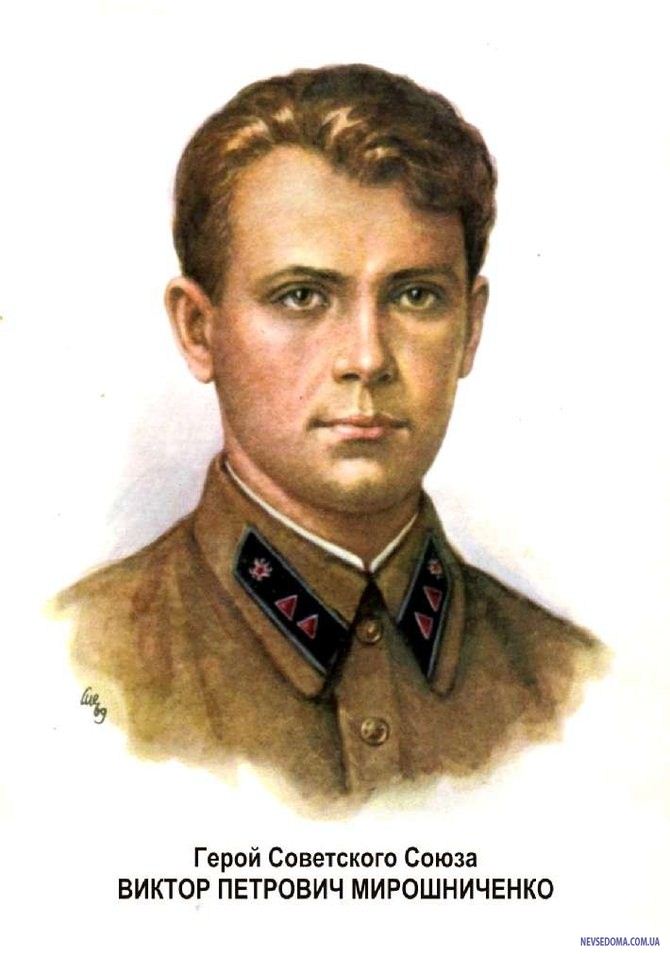
26. Lyudmila Mikhailovna Pavlichenko, sniper, born in 1917, Ukrainian.
Kyiv University student Lyudmila Pavlichenko voluntarily went to the front from the first days of the Great Patriotic War. As part of the 25th Chapaev Division, it retreated east to Odessa. Together with the division, as part of a sniper platoon, she fought for Odessa for two and a half months, then for Sevastopol. On its combat account there are more than 300 exterminated fascists. In heavy defensive battles, Komsomol member Pavlichenko showed exceptional courage and inexhaustible perseverance. She trained many excellent snipers, who, following her example, destroyed more than one hundred fascists.
For courage, military skill, and courage shown in the fight against the Nazis, Lieutenant L. M. Pavlichenko was awarded the title of Hero of the Soviet Union.

27. Alexander Mikhailovich Roditelev, during the battles for Koenigsberg in April 1945, the commander of a sapper platoon, junior lieutenant Roditelev, with eight sappers, acted as part of an assault group.
With a swift rush, the assault group reached the enemy artillery positions. Without wasting any time, Roditelev ordered the artillerymen to attack. In the ensuing hand-to-hand combat, he himself destroyed six fascists. Unable to withstand the onslaught of Soviet soldiers, 25 German soldiers surrendered, the rest fled, leaving 15 heavy guns. A few minutes later, the Nazis attempted to return the abandoned guns. The sappers repulsed three counterattacks and held artillery positions until the main forces arrived. In this battle, a group of sappers under the command of Roditelev destroyed up to 40 Nazis and captured 15 serviceable heavy guns. The next day, April 8, Roditelev with twelve sappers blew up an enemy bunker, cleared 6 blocks of the city from the Nazis and captured up to 200 soldiers and officers.
For the courage and courage shown in battles with the German fascists, A. M. Roditelev was awarded the title of Hero of the Soviet Union.

28. Nelson Georgievich Stepanyan, during the Great Patriotic War, the commander of the attack aviation regiment Stepanyan made 239 successful sorties to attack and bomb enemy ships.
Stepanyan became famous for his high military skill, surprise and audacity in striking the enemy. One day, Lieutenant Colonel Stepanyan led a group of planes to bomb an enemy airfield. The attack aircraft dropped their bombs and began to leave. But Stepanyan saw that several fascist planes remained undamaged. Then he directed his plane back, and, approaching the enemy airfield, lowered the landing gear. The enemy's anti-aircraft artillery ceased fire, thinking that the Soviet plane was voluntarily landing on their airfield. At that moment, Stepanyan stepped on the gas, retracted the landing gear and dropped the bombs. All three aircraft that survived the first raid burst into flames with torches. And Stepanyan’s plane landed safely at its airfield.
On October 23, 1942, for the excellent performance of command tasks, the glorious son of the Armenian people was awarded the title of Hero of the Soviet Union. He was awarded the second Gold Star medal posthumously on March 6, 1945.

29. Maguba Guseinovna Syrtlanova, deputy commander of the night bomber squadron, born in 1912, Tatar, communist.
Guard senior lieutenant Syrtlanova fought in the North Caucasus, Taman Peninsula, Crimea, Belarus, Poland and East Prussia during the Great Patriotic War. In battles she showed exceptional courage, courage and courage, and flew 780 combat missions. In the most difficult meteorological conditions, Syrtlanova guided groups of aircraft to specified areas with great accuracy.
For the courage and bravery of the guard, senior lieutenant M. G. Syrtlanova was awarded the title of Hero of the Soviet Union.

